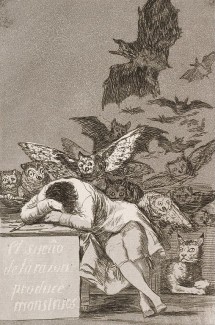Peace by Gene Wolfe

Sleep of Reason - Goya
Early in The Melancholy of Resistance the sudden fall of a giant tree heralds the beginning of weird events. Gene Wolfe’s Peace begins with the fall of huge tree while Alden Weer sleeps:
“The elm tree planted by Eleanor Bold, the judge’s daughter, fell last night. I was asleep and heard nothing, but from the number of shattered limbs and the size of the trunk there must have been a terrible crashing. I woke – I was sitting up in my bed before the fire – but by the time I was awake there was nothing to hear but the dripping of the melting snow running from the eaves. I remember that my heart pounded and I was afraid I was going to have an attack, and then, fuzzily, thought that perhaps the heart attack had wakened me, and then that I might be dead.”
The fall of the elm tree which was planted by Eleanor Bold, the judge’s daughter, is obviously unsettling. A careful reader will learn why the tree matters..
Alden Weer isn’t sure of the dimensions of his house. It isn’t static. Nor is time. Alden hops about through the ages of his life, consulting Dr Black as a boy and Dr Van Ness as a man.
“Dr. Van Ness is slightly younger than I, very competent-looking in that false way of medical men on television dramas. He asks what seems to be the matter, and I explain that I am living at a time when he and all the rest are dead, and that I have had a stroke and need his help.
‘How old are you, Mr Weer?’
I tell him. (My best guess.)
His mouth makes a tiny noise, and he opens the file folder he carries and tells me my birthday. It is in May, and there is a party, ostensibly for me, in the garden. I am five. The garden is the side yard, behind the big hedge. It is a large yard, I suppose, even for adults, big enough for badminton or croquet, though not for both at once; for five it is enormous. Children come in boxy, tottering cars, as though they were toys being delivered in little trucks, the girls in pink lace dresses, the boys in white shorts and navy shorts. One boy has a cap, which we throw into the blackberries.”
It isn’t nice to throw a guest’s cap into the blackberries, but worse is to come at this party..
In the afterword to Peace, Neil Gaiman tells the reader that, as a teenager when he first read the book, he was puzzled by the Gahan Wilson artwork: “a white title on a white cover, the word ‘Peace’ hiding ghosts and skeletons and monsters… Why did this sweet, gentle, meandering reminiscence have scary-funny Gahan Wilson skeletons and suchlike on it? Obviously Gahan Wilson (my favorite living cartoonist) had misunderstood the book, and they had put his cover on it because it was commercial”. The young Gaiman also thought that Gene Wolfe must have become a much better writer by the time he wrote books like The Fifth Head of Cerberus, the like of which had attracted Gaiman to Peace. The older Gaiman rereads Peace and learns that Alden Weer may meander, but he is neither sweet nor gentle and Gahan Wilson knew what he was doing after all.
As Gaiman says, “If you are reading a book by Gene Wolfe, trust the author, and do not, for a moment, trust the author.”
Leave a comment...
While your email address is required to post a comment, it will NOT be published.


2 Comments